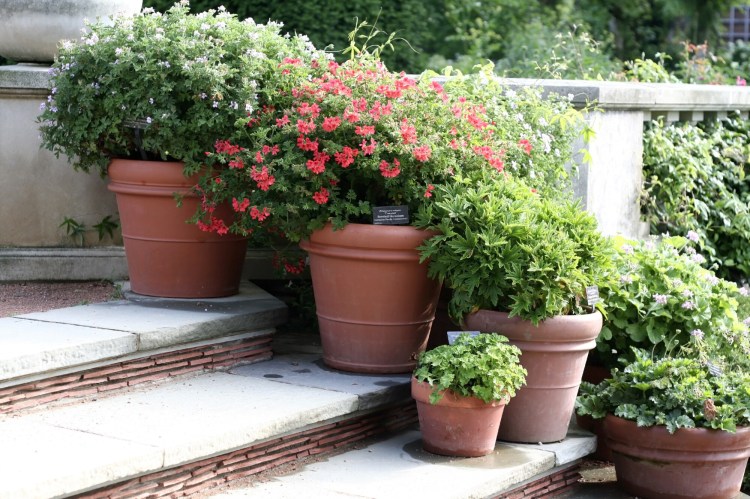A popular and pricy southern New England nursery that shall remain nameless will provide a staff member to lead you and a guest through their greenhouses and let you select five annuals, which they will then plant in a pot for you to take home. The price is $65.
The trip would be fun, but the offer has a couple of problems, not even counting the price. No matter how large their flower beds, most gardeners are going to want many more than one pot of annuals – and I’m not even including the ones they take to cemeteries for relatives’ grave sites or the many houseplants they move outdoors come summertime. Potted annuals on patios, decks, porches and walkways add so much color and texture.
I’ll start with the containers, move on to the planting medium, and finally the plants themselves. I’ve saved the best for last so you’ll read until the end.
Pots can be anything. Yes, you can spend money for gorgeous ceramic containers, but that’s not mandatory. My wife and I re-use the containers that once contained the shrubs and perennials that make up our landscape. They are plain but not ugly, and anyway, we think the attention should go to the flowers and foliage, not the pots.
You can paint the plain nursery pots to coordinate with your house colors. Red doors? Spray paint the pots red, using paint that works on plastic. The plain nursery pots are also helpful if you have a ceramic or metal pot without a drainage hole (why does anybody make those?). Put the attractive pot where you want it, add bricks in the bottom and place the planted nursery container on top. If you ever water too much, simply remove the planted container and tip the pot sideways to empty it.
Soil is more complicated. You won’t get good results if you dig up soil from your vegetable garden. It will be too compacted and may contain insects you don’t want. To make the garden soil for a container lighter and more drainable, mix it with an equal amount of compost and/or coir. It will still have weed seed and possibly insects, but they shouldn’t be a big problem.
It’s easier to use a standard potting mix, though. Coast of Maine Organics’ Bar Harbor Blend is popular and does a good job, as does Pro-Mix, a national brand. But both contain peat moss, which environmentally savvy gardeners avoid because harvesting peat moss hastens climate change. The potting mixes also come in plastic bags, another material I try to avoid for environmental reasons.
One option is to save the soil you used last summer and put it in the bottom of this year’s pot. Top up the pot with fresh soil mix, and add slow release fertilizer or your own compost into the recycled soil.
Now let’s get to the fun part – the plants. You can pot annuals or perennials; vegetables or flowers or foliage.
The most common plant for containers is a geranium; native to Africa and Australia, its botanical name is pelargonium. Confusingly, the eastern U.S. has a native geranium, with the common name cranesbill. Anyway, pelargoniums are reliable bloomers and especially resistant to drought, which is why they are popular for cemetery boxes. But you want more than exciting plants than that.
Begonias are a favorite, with bright long-lasting blossoms in a variety of colors. Begonias include nonstop varieties with giant blooms as big as the palm of your hand, angel wing begonias with wild-looking leaves, and wax begonias with waxy leaves and fingernail-size blooms. All need regular watering.
Heuchera, a perennial that is grown for its foliage rather than its flowers, makes a nice potted plant. It comes in green, red, purple, yellow, almost black, and combinations of those colors. It is a wonderfully low-maintenance, front-of-the-border plant. If you buy it and put it on display in the front of a pot, come fall, you can plant it in your perennial garden.
Another good candidate for potting is the perennial foliage plant lamium, which has variegated foliage in green and silver or white and green. Its lovely flowers come in white, pink and lavender. Avoid the lamium with yellow blooms, as it will grow over anything in its path.
Cannas, with their height, huge flowers and striking leaves, are a standout plant for pots. The blooms come later in the season, but if you shop carefully, you can find cannas with colorful foliage. You can over winter them inside, either growing in a pot, or in storage, with your gladiolas and dahlias.
On my desk, beside the terrarium I built a few weeks ago, I have an oxalis, sometimes called false shamrock. It has triangular red leaves and light pink flowers that can last from spring to fall. Sometime after Memorial Day, it can happily go outside.
Sweet potato vine is ideal for a trailing plant in a pot – whether in a hanging pot or on a table. The leaves come in several colors and, if you tend the vine carefully all summer, you may find some small sweet potatoes when you empty the pot in the fall.
My wife Nancy and I also grow tomatoes and peppers in pots because they like the warm, sunny spot on our front steps. Bright red peppers are especially attractive.
These are just a few suggestions. Take an unguided, entirely free tour through your local nursery and read the labels in the pots to assist you. (Just be sure to put the labels back in the pot.)
Tom Atwell is a freelance writer gardening in Cape Elizabeth. He can be contacted at: tomatwell@me.com.
Send questions/comments to the editors.



Comments are no longer available on this story